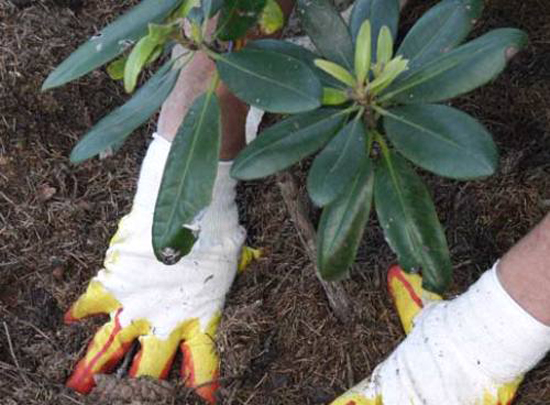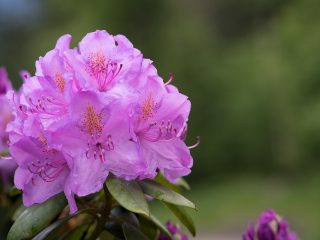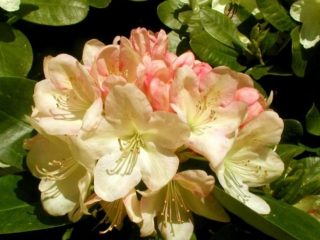Content
Rhododendron Hania is a variety developed from an evergreen shrub. The plant is considered a rare crop for temperate climates. The Khanya variety is recommended for cultivation in the central part of Russia.
Description of Han's rhododendron
This is a compact shrub up to 1 m high. The leaves of the plant are dark green all year round. From late May to June it forms lush inflorescences of soft pink color. In the central part of the bud there are dark brown anthers. The flowers have a pleasant smell. According to reviews and descriptions from gardeners, the rhododendron variety Hanya, shown in the photo, has acclimatized well to the cold winters of Russia.
The peculiarity of this variety is its short stature. Thanks to this, Hanya rhododendron is used in border plantings. The shrub forms a compact but strong root system.
Winter hardiness of Hanya rhododendron
Rhododendron Hanya is considered a winter-hardy variety. It can withstand temperatures during cold periods down to -28 degrees.
Planting and caring for Hanya rhododendron
Rhododendron Hania is planted in the spring. You can replant in the summer, but not during flowering.After this period, you should also not touch the plant for 2 weeks.
Selection and preparation of a landing site
Rhododendron Hania requires fertile soil. It should be acidified. The shrub is light-loving, but it cannot be planted in an area that receives direct sunlight. It tolerates shade well, so choose the northern side of buildings for planting. Rhododendron Hania can be planted near an artificial pond, under the canopy of other trees.
Seedling preparation
A shrub seedling of the Hanya variety should be purchased at a specialized store. Gardeners prefer those that have a closed root system. Their survival rate is higher. Bare-rooted seedlings are cheaper, but their survival rate is lower. Before planting, young plants are prepared for this procedure. Place the roots in water, wait until air bubbles stop releasing, and then begin planting.
Landing rules
Before planting Hanya rhododendron, make a hole. Gardeners use dimensions in the ratio of depth and diameter of 40 by 60 cm. Any drainage that is available is placed at the bottom. Then prepare the soil and plant:
- Take a mixture of peat, loam and clay in a ratio of 2:1:0.5.
- The soil in the hole is compacted and a hole is prepared for the root system.
- Place the seedling in the hole.
- Fill the soil and compact it.
When planting, the grafting site is left above ground level. The root collar is placed flush with the ground. An earthen roller is made around the circumference of the tree trunk to retain moisture.
After planting is completed, the rhododendron is watered. The tree trunk area is mulched to a height of 5 cm.Peat, oak bark, pine needles or moss are used. If there are buds during planting, some of them are removed so that the plant takes root better. Further care consists of weeding, watering, fertilizing, and removing pests.
Watering and fertilizing
Rhododendron Hania is a moisture-loving shrub. Requires abundant moisture during bud formation and flowering. Water 2-3 times during the week. One bucket of liquid is used for each bush. Use warm soft water.
It is recommended to collect moisture during rain. Tap water can be made soft by adding a handful of peat to it the day before use.
Rhododendron needs acidic soil, so the water is acidified with citric acid. For this purpose, take 1 tbsp. l. products for 10 liters of water. Use table vinegar - 40 mg per 1 liter of liquid. Water abundantly until the soil is wet by 30 cm. The need for moisture is determined by the leaves. Watering is needed if the leaves become dull and soft.
Rhododendron Hania responds well to feeding. From the beginning of spring until the end of July, regular additions of nutrients are carried out. Fertilizing is practiced in liquid form. Manure is mixed with water, maintaining a ratio of 1:15. It is used as a top dressing. Before this, the bush must be watered.
It is also recommended to use mineral fertilizers:
- ammonium sulfate;
- potassium phosphate;
- potassium sulfate;
- superphosphate.
Trimming
Hania rhododendron requires minimal pruning. The plant itself forms a beautiful bush shape. Remove damaged, protruding branches. Pruning is done for the purpose of rejuvenation. It is performed in the spring before the sap flows. The shoots are cut off and the sections are treated with garden varnish. To make the Khanya rhododendron look lush, pinch the tops of the shoots.If the bush has been damaged by frost, perform gradual pruning. First, shoots of a part of the bush up to 40 cm are removed. In another year, the second part is cut off. Rhododendron blooms profusely and for a long time if the wilted buds are removed. Under such conditions, it will form buds for the next season.
Preparing for winter
Rhododendron Hania requires preparation for winter. During dry autumn, it is moistened. Use 10-12 liters of water per bush. In rainy autumn weather, additional moisture is not necessary.
Before the onset of cold weather, the root zone of the Han rhododendron is covered with a layer of peat. In areas with cold winters, bushes are covered with any material. Branches of coniferous trees are placed between the shoots, and the bush is slightly tied with rope.
According to other recommendations, they make a frame from slats and cover it with any material except film.
Reproduction
Having once planted a rhododendron bush, gardeners can propagate it themselves. There are different ways to do this:
- When propagated by seeds, the shrub blooms after a long time, 6 or 8 years. Sow them in containers with moist soil, do not cover them with soil. Cover with glass and leave in a warm place. Shoots appear within a month. As soon as a couple of leaves grow, they are transplanted into separate containers. For the first year, young seedlings live in a greenhouse or indoor conditions. They are planted only next year.
- Lignified rhododendron branches are used for cuttings. Cut cuttings 8 cm high. Leaves at the bottom are removed. They are kept in a root formation stimulator for up to a day. They are buried in a soil mixture of peat and sand. Cover with a cut plastic bottle.Cuttings produce roots within 4 months. After this, the rooted shoot is transplanted into a container with peat and oak bark, in a ratio of 2 to 1. It overwinters indoors at a temperature of +12 degrees.
- Propagation of rhododendron by layering is a more affordable method. In spring, the green shoot is placed in a longitudinal depression. The middle part is covered with soil and pinned in any way for reliability. The top of the shoot is tied to a peg, directed vertically. In the future, the cuttings are cared for in the same way as an adult bush. Where the shoot is covered with soil, it forms roots. Next spring it can be separated and planted in the desired location.
- When transplanting, a large bush of Hanya rhododendron is divided and planted in new holes. A year later, young bushes form flowering shoots.
Diseases and pests
The Hanya variety, like any rhododendron, can suffer from fungal infections.
The cause of rhododendron diseases is poor soil aeration and excess moisture. Copper sulfate will cope with leaf spot and rust. Cancer-affected shoots and leaves are removed. To prevent chlorosis, iron chelate is added when watering. To prevent diseases, the shrub is treated with Bordeaux mixture.
The most commonly noticed pests are:
- mealybugs;
- scale insects;
- weevils;
- spider mites;
- rhododendron flies;
- slugs and snails.
Slugs and snails are collected and the plantings are treated with Tiram fungicide. Spraying with Diazinon kills ticks, flies and weevils. Other pests will be destroyed by Karbofos.
Even after flowering, the healthy Hanya rhododendron bush shown in the photo looks attractive.
Conclusion
Rhododendron Hania is an unpretentious and winter-hardy plant. Almost never gets sick. With minimal care it will decorate any garden.











